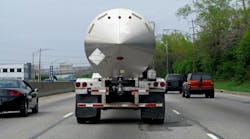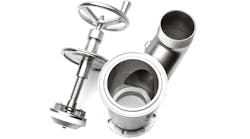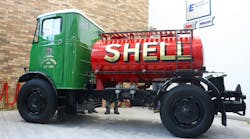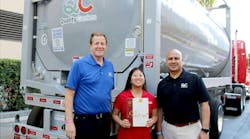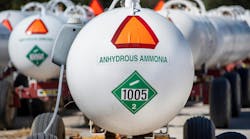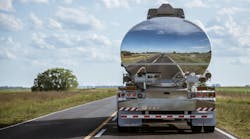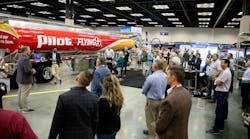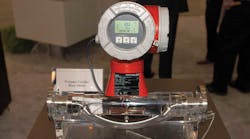SELECTING the optimal meter for a storage terminal application is “a very involved process,” according to Joshua Rose, product marketing manager for FMC Technologies. To achieve the best measurement, the process must involve the right meter, superior accuracy and stability, and low risk of error.
Rose provided a detailed review of terminal meters during a session entitled “Selecting the Optimal Meter for Your Terminal Application.” He made the presentation during the International Liquid Terminals Association's 30th Annual International Operating Conference that was held May 24-26 in Houston, Texas.
Terminal metering technologies involve electronic output Positive Displacement (PD) meters, Coriolis mass flow and density meters, and turbine meters with flow conditioner.
Meter selection criteria include: system/product characteristics (system operating conditions and fluid properties); application (terminal, fuel-oil delivery, and aviation fueling), system characteristics (flow range, pressure, temperature, and back pressure); and product characteristics (viscosity, density, vapor pressure — especially for LP-gas — lubricating quality, and containments.
Vapor pressure is the pressure required to keep the product in a liquid state. At 60°F, propane's vapor pressure is 105 psi, butane 26, gasoline 10, and diesel and crude oil 5. At 100°F, propane's vapor pressure is 184, butane 50, gasoline 20, and diesel and crude oil 10.
Rose said PD meters are unique in that they are not an inference device. They directly measure volume by counting rotor revolutions.
“Our meter has a fixed cannon shaft in the center, along with a rotor and two blades that rotate around the shaft,” he said. “As the rotor rotates around the shaft, it follows the periphery, and that causes the blades to slide in and out. As fluid enters the meter, its' diverted off the ground into a measuring chamber. The process of these blades extending and contracting causes the product to divide up into segments. While we're not literally counting every segment, the continuous flow of fluid through the meter produces continuous rotation for the rotor and continuous segmentation.
“You can see we have direct pulse on the side of meter. The end result is that you can determine flow rate. Meters are not only used for measuring volume, but also for processing.”
He said there are two different types of flow through a PD meter: displacement, which is the amount of product that goes through the meter and is measured by being segmented; and slippage, the amount of fluid that goes through the meter and squeezes past through the clearances of the blades and rotors.
“The amount of slippage depends on product viscosity — the lower the viscosity, the more slippage,” he said. “But that's not necessarily a bad thing. When you calculate meters, you're taking slippage into account.”
Advantages of PD meters: high accuracy and stability; volume directly measured and outputted; no flow conditioning required; capable of measuring all refined petroleum products; and low pressure drop.
Coriolis meters
A Coriolis meter is an inference meter because volume is being inferred.
“These meters have a set of drive coils at both the upstream and downstream end,” he said. “One set of coils is driving the tubes and forcing them to operate and the second set is measuring. Whenever the meter is at zero flow, whenever it's filled with process fluid, those two stay parallel to each other
“In the flow mode — also known as ‘Twist’ — you have different mechanical forces at play. Sensors are trying to drive the coils and at the same time, tubes vibrate against each other. And whenever these two types of movements combine, we see a difference. This phase difference has been equated to mass-flow rate. The faster the flow is through the meter, the greater that phase difference.”
The mass flow (lbs/minute) divided by the density (lbs/gallon) equals the volume flow (gallons per minute).
The advantages of Coriolis mass meters: direct mass and density measurements; no moving parts; and flow conditioning is not normally required.
“Because we're not actually measuring flow rate, we don't care what the fluid profile looks like going into the tubes,” Rose said.
Turbine meters are inference-guided. Inferred volume throughput is equal to fluid velocity multiplied by area, where fluid velocity is proportional to the rotor velocity.
“We're measuring the rotational speed of that rotor and equating it to volume metric,” he said. “One caveat with turbine meters is that they do require flow conditioning, which reduces swirl and velocity profile distortion.
“The fluid coming into the first level is nice and straight, but the fluid coming out of the second is not. Fluid does not maintain the same speed across the cross section of pipe. It's forced to speed up somewhat on the outside but stays at the same level inside. If you have rotor spinning in the opposite direction, it makes the rotor spin slower.”
A compact flow conditioner minimizes installation space and is suitable for applications with constant minimum/maximum flow rates.
The advantages of turbine meters: volume output is directly related to rotor movement; wide flow range; small size and weight; low cost of ownership; and wide temperature and pressure ranges.
In terms of applications, turbine meters are more prevalent with LP-gas, but usage starts to tail off at the other end of the spectrum with furnace and diesel oil and heavier products. Coriolis meters are common at that range, and also, to a lesser extent, PD meters.
Terminal applications involve product loading and unloading; ethanol and biodiesel blending; asphalt and LP-gas loading. In the product unloading system, air elimination is essential. The valve can be configured and connected to the air eliminator to stop flow when air is present.
Ethanol blending
With ethanol and biodiesel blending, “on-spec” blends must be ensured from start to finish. This requires accurate metering, an appropriate blending method, and a sound system hydraulic. Blending configurations typically used: splash, sequential, ratio, side (wild) stream ratio, and a hybrid combination of ratio/sequential. A flow-controlled additive can be used for all blend configurations.
Asphalt-loading terminals, in many cases, are replacing weigh scales with meters. PD meters provide volume output with inferred mass by density and Coriolis Mass meters provide mass and volume output.
“At an LPG-loading terminal, it is typically done by weight, so it kind of makes sense to use Coriolis because it will measure directly,” he said. “But with LPG, you need to consider unique fluid properties (low vapor pressure, low viscosity and lubricating quality). You can use any of these types of meters: turbine (with flow conditioner), PD (with LPG trim), and Coriolis Mass (with corrected volume output).
“With fuel-oil delivery, you typically see PD meters with mechanical or electronic output. Aviation-fuel delivery typically uses PD meters with non-ferrous construction. PD meters tend to cover the entire application. They're excellent for all and good for asphalt and ethane, propane, and butane and LPG. Turbine meters are excellent for ethanol and water, gasoline and ethane, propane, butane and LPG. Coriolis is fair over the entire range and good to excellent with asphalt, ethane, propane, butane, and LPG, if measured in mass.” ♦
